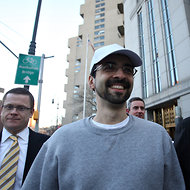Of all the outraged responses to the Rolling Stone cover of Dzhokhar Tsarnaev, the 19-year-old suspect in the Boston marathon bombings, those from Boston were particularly acute. Mayor Thomas Menino wrote a letter of protest to Rolling Stone and several retailers with Boston ties said they would not sell the controversial issue.
And then on Thursday, Boston Magazine responded to Rolling Stone’s editorial decision with one of its own, publishing photos of the manhunt and arrest of Mr. Tsarnaev. The images were taken by Sgt. Sean Murphy, a photographer with the Massachusetts State Police who was described as “furious” about the Rolling Stone cover and accused the magazine of “glamorizing the face of terror.”
His protest, which included graphic photos of Mr. Tsarnaev during his capture, ended up creating a controversy of its own. According to Boston Magazine, Sergeant Murphy was relieved of duty just hours after he turned over hundreds of photos to the magazine.
Mr. Murphy’s actions may have put him in hot water at work, but it is not hard to understand the emotions that drove his decision. News developments, and the way they are presented in the news media, always fall harder on some than others, especially victims, families of victims and first responders.
The ubiquitous footage of the fall of the World Trade Center towers is disturbing for anyone to watch, but for the many thousands of people related to people who died there viewing that footage produces a far different experience. Similarly, people who are related to victims who lost their lives or limbs as the result of the Boston Maraton bombings — Mr. Tsarnaev has pleaded not guilty to federal charges in connection with bombings — were appalled by the magazine’s decision. But the misery of some should not determine the value to the whole. There are things we need to know, including the fact that Mr. Tsarnaev, almost banal in his teenage aspects, is suspected of having become a cold-blooded killer.
The power of visual context was vividly illustrated on Wednesday when vast swaths of the Internet — and several prominent retailers — vehemently protested the Rolling Stone cover.
Actually, it wasn’t the who, but the how and where. With his thick, tousled hair falling into his eyes above direct brown eyes and a young man’s goatee, the reported bomber looked like many other American teenagers. Except there he was on the cover of the Rolling Stone, a storied piece of American cultural real estate about which songs have been written.
Absent that context, the image was unremarkable. It was a self-shot photo, or “selfie,’’ and there is no more ubiquitous photographic image in the current media age. Young people use their phones to take pictures of a lot of things but they love taking pictures of themselves. They strive to look as good, and as hot, as they can. Those who found the styling offensive can blame Mr. Tsarnaev. That photo is the way he wanted the world to see him. It was a compelling enough image that The New York Times decided to use it on its front page, where it came and went without a great deal of reaction.
In other words, it was not the image of Mr. Tsarnaev that ignited outrage, it was the frame. With its headline callouts to Jay Z and Willie Nelson on the current issue, and a history of hosting rock luminaries, there were suggestions that the magazine was conferring iconic status on a man who has been charged with a brutal act of terrorism. People suggested that Rolling Stone used the image to sell magazines, which, of course, they did. Editorially, the cover was a win. (The Boston media writer Dan Kennedy called it “brilliant.”)
When is the last time someone said to you, “Did you see the cover of Rolling Stone?” In a cluttered informational marketplace, magazines are in a dogfight for attention, not just with one another, but with every other form of media.
Part of the mass umbrage would seem to stem from a misunderstanding of the magazine and its cover. From the very beginning, Rolling Stone has seen long-form journalism as part of its mission, and more recently has proven its journalistic chops with important stories about Gen. Stanley A. McChrystal and the so-called vampire squids of Goldman Sachs. Those were good, important stories and while the profile about Mr. Tsarnaev did not break a lot of new ground, it did an excellent job of explaining how someone who looked like the kid next door radicalized in place and, according to the federal charges, decided to attack innocents to make a political point. There is civic and journalistic value in finding out more about who this person is, and if the cover created in-bound interest, that would seem to be to the good.
Still, many piled on, accusing Rolling Stone of a cynical play for attention while they sought some of the same in their reaction. The actor James Woods, among others, found himself on the moral high ground, issuing a profane and personal rebuke to Jann Wenner, the owner and publisher of Rolling Stone.
The story and cover treatment of Mr. Tsarnaev was clinically an act of journalism. Commercial and editorial motives were at work, as they are when almost anyone publishes anything. People who read beyond the cover discovered that the pretty boy on the front appeared to have deep, nascent ugliness in his heart. Just as you can’t judge a book (or a magazine) by its cover, the kid behind that confident selfie was, it seems, a big, hot mess.


